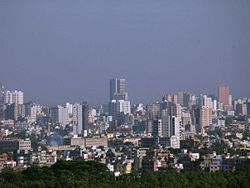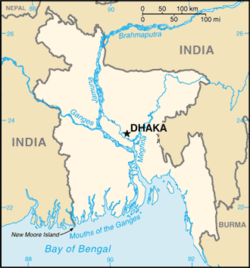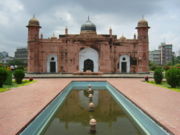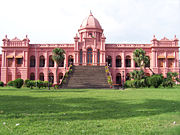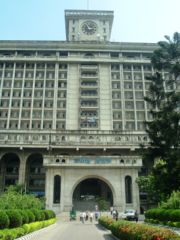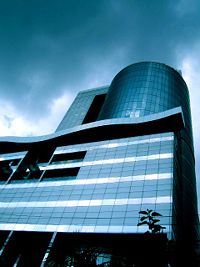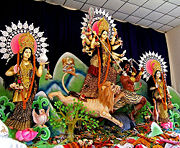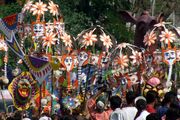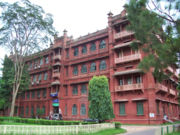Dhaka
2008/9 Schools Wikipedia Selection. Related subjects: Asia; Asian Cities
| Dhaka | |
| Skyline of Dhaka City | |
| Nickname(s): City of Mosques and Shrines | |
| Location of Dhaka in Bangladesh | |
| Coordinates: | |
|---|---|
| Country | Bangladesh |
| Administrative District | Dhaka District |
| Government | |
| - Mayor | Sadeque Hossain Khoka |
| Area | |
| - City | 145 km² (56 sq mi) |
| Population (2006 est.) | |
| - City | 6,724,976 |
| - Density | 14,608/km² (37,834.5/sq mi) |
| - Metro | 11,918,442 |
| Time zone | BST ( UTC+6) |
| This article contains Indic text. Without rendering support, you may see question marks, boxes or other symbols instead of Indic characters; or irregular vowel positioning and a lack of conjuncts. |
Dhaka is the capital of Bangladesh and the principal city of Dhaka District. Located on the banks of the Buriganga River, Dhaka, along with its metropolitan area, has a population of 11 million, making it the largest city in Bangladesh. With its colourful history, Dhaka is known as the 'City of Mosques' and for its famous fine Muslin cloth which has a great ethnic value.
Under Mughal rule in the 17th century, the city was also known as Jahangir Nagar, and was both a provincial capital and a centre of the world-wide muslin trade. The modern city, however, was developed chiefly under British rule in the 19th century, and soon became the second-largest city in Bengal after Calcutta (presently Kolkata). With the partition of India in 1947, Dhaka became the administrative capital of East Pakistan, and later, in 1972, the capital of an independent Bangladesh. During the intervening period, the city witnessed widespread turmoil; this included many impositions of martial law, the declaration of Bangladesh's independence, military suppression, devastation during war, and natural calamities.
Modern Dhaka is the centre of political, cultural and economic life in Bangladesh. It has both the highest literacy rate - 62.3% - and the most diverse economy amongst Bangladeshi cities. Although its urban infrastructure is the most developed in the country, it is nonetheless a fighting metropolitan city with challenges such as pollution, congestion, and lack of adequate services due to the rising population. In recent decades, Dhaka has seen modernisation of transport, communications and public works. The city is attracting large foreign investments and greater volumes of commerce and trade. It is also experiencing an increasing influx of people from across the nation. To fight rising traffic congestion and population rise in the capital city, the national government has implemented a policy for rapid urbanisation of surrounding areas and beyond by recent introduction of ten year tax on income holiday for new construction of all types of facilities and buildings outside Dhaka.
History
The existence of urbanised settlements in the area that is now Dhaka dates from the 7th century. The city area was ruled by the Buddhist kingdom of Kamarupa and the Pala Empire before passing to the control of the Hindu Sena dynasty in the 9th century. Many believe that the name of the city was derived after the establishment of the Goddess Dhakeshwari's temple by Ballal Sena in the 12th century. Dhaka and its surrounding area was identified as Bengalla around that period. The town itself consisted of a few market centers like Lakshmi Bazar, Shankhari Bazar, Tanti Bazar, Patuatuli, Kumartuli, Bania Nagar and Goal Nagar. After the Sena dynasty, Dhaka was successively ruled by the Turkish and Afghan governors descending from the Delhi Sultanate before the arrival of the Mughals in 1608.
The development of townships and a significant growth in population came as the city was proclaimed the capital of Bengal under Mughal rule in 1608. Mughal subahdar Islam Khan was the first administrator of the city. Khan named the town "Jahangir Nagar" (City of Jahangir) in honour of the Mughal emperor Jahangir, although this name was dropped soon after Jahangir's death. The main expansion of the city took place under Mughal general Shaista Khan. The city then measured 19 by 13 kilometres (12 by 8 mi), with a population of nearly a million people. The city passed to the control of the British East India Company in 1765 after the Battle of Plassey. The city's population shrank dramatically during this period as the prominence of Kolkata rose, but substantive development and modernisation eventually followed. A modern civic water supply system was introduced in 1874 and electricity supply launched in 1878. The Dhaka Cantonment was established near the city, serving as a base for British and Bengali soldiers.
During the abortive Partition of Bengal in 1905, Dhaka was declared to be the capital of the newly established state of Eastern Bengal and Assam, but Bengal was reunited in 1911. Following the Birth of India in 1947, Dhaka became the capital of East Bengal in the State of Pakistan. The city witnessed minimal communal violence. A large proportion of the city's Hindu population departed for India, while the city received a large influx of Muslims Muslim. After Bangladesh's independence in 1971, Dhaka with the status of the nation's capital, the growth of commerce and industry along with the city's population rose dramatically in the following decades, which created further challenges to services and infrastructure. As the centre of regional politics, Dhaka saw an increasing number of political strikes and incidents of violence. The adoption of Urdu as the sole official language of Pakistan led to protest marches involving large crowds. Known as the Bengali Language Movement, the protests resulted in police firing which killed students who were demonstrating peacefully. Throughout the 1950s and '60s, Dhaka remained a hotbed of political activity, and the demands for autonomy for the Bengali population gradually gained momentum.
The 1970 Bhola cyclone devastated much of the region, killing an estimated 500,000 people. More than half the city of Dhaka was flooded and millions of people marooned. With public anger growing against ethnic discrimination and poor cyclone relief efforts from the central government, Bengali politician Sheikh Mujibur Rahman held a nationalist gathering on March 7, 1971 at the Race Course Ground. An estimated one million people attended the gathering, leading to the March 26 declaration of Bangladesh's independence. In response, the Pakistan Army launched Operation Searchlight, which led to the arrests, torture and killing of thousands of people, Muslims and Hindus Bengali intellectuals. After nine months of bloody battle with Bangladesh Forces, the Pakistani Army surrendered to the Coalition Forces led by the Indian Army on December 16 marking the end of the independence war of Bangladesh. The post-independence period has seen a rapid and massive growth of the city population, attracting migrant workers from rural areas across Bangladesh. A real estate boom has followed the expansion of city limits and the development of new settlements such as Bashundhara, Mirpur and Motijheel.
Geography and climate
Dhaka is located in central Bangladesh at , on the eastern banks of the Buriganga River. The city lies on the lower reaches of the Ganges Delta and covers a total area of 815.85 square kilometres (315 sq mi). It consists of seven principal thanas — Dhanmondi, Kotwali, Motijheel, Paltan, Ramna, Mohammadpur, Sutrapur, Tejgaon — and 14 auxiliary thanas — Gulshan, Lalbagh, Mirpur, Pallabi, Sabujbagh, Dhaka Cantonment, Demra, Hazaribagh, Shyampur, Badda, Kafrul, Kamrangir char, Khilgaon and Uttara. In total the city has 130 wards and 725 mohallas. Dhaka district has an area of 1463.60 square kilometres (565 sq mi); and is bounded by the districts of Gazipur, Tangail, Munshiganj, Rajbari, Narayanganj, Manikganj. Tropical vegetation and moist soils characterise the land, which is flat and close to sea level. This leaves Dhaka susceptible to flooding during the monsoon seasons owing to heavy rainfall and cyclones.
Dhaka experiences a hot, wet and humid tropical climate. The city is within the monsoon climate zone, with an annual average temperature of 25 °C (77 °F) and monthly means varying between 18 °C (64 °F) in January and 29 °C (84 °F) in August. Nearly 80% of the annual average rainfall of 1,854 millimetres (73 in) occurs between May and September. The environment of Dhaka is facing serious threats from pollution caused by the city's rapid expansion, congestion and industrial activities. Increasing air and water pollution emanating from traffic congestion and industrial waste are serious problems affecting public health and the quality of life in the city. Water bodies and wetlands around Dhaka are facing extinction as these are being filled up to construct multi-storied buildings and other real estate developments. Coupled with pollution, such erosion of natural habitats threatens to destroy much of the regional biodiversity.
| Climate in Dhaka | |||||||||||||
|---|---|---|---|---|---|---|---|---|---|---|---|---|---|
| Month | Jan | Feb | Mar | Apr | May | Jun | Jul | Aug | Sep | Oct | Nov | Dec | |
| Avg high temperature (°F) | 76° | 80° | 87° | 89° | 89° | 88° | 87° | 88° | 87° | 87° | 83° | 77° | |
| Avg low temperature (°F) | 58° | 63° | 72° | 77° | 79° | 81° | 81° | 81° | 80° | 77° | 69° | 61° | |
| Average Precipitation (inches) | 0.3" | 0.8" | 2.3" | 4.6" | 10.5" | 14.1" | 15.7" | 12.5" | 10.1" | 6.4" | 1.2" | 0.2" | |
| Source: WeatherBase.Com | |||||||||||||
Civic administration
The Dhaka municipality was founded on August 1, 1864 and upgraded to " corporation" status in 1978. The Dhaka City Corporation is a self-governing corporation which runs the affairs of the city. The incorporated area is divided into several wards, which have elected commissioners. The mayor of the city is elected by popular vote every five years, and the post is presently held by Sadeque Hossain Khoka. The Dhaka Education Board is responsible for administering all public schools and most private schools with the exception of English-medium schools and madrassahs. All madrassahs in Bangladesh are governed by a central board while English-medium schools are under separate educational and governance structures.
Dhaka suffers from a chronically high crime rate and frequent incidences of political and religious violence. An undermanned and ill-equipped police force has caused governments to occasionally deploy the Bangladesh Army and paramilitary forces in major efforts to curb crime. Aside from Chittagong, Dhaka is the only city in the country with a water-borne sewage system, but this serves only 25% of the population while another 30% are served with septic tanks. Only two-thirds of households in Dhaka are served by the city water supply system. More than 9.7 million tonnes of solid wastes are produced in Dhaka city each year. While private and government efforts have succeeded in collecting garbage city-wide and using it as manure, most solid wastes are often dumped untreated in nearby low-lying areas and water bodies. Dhaka has one of the highest rates of death from infectious disease of any city in Asia.
The city is divided into 10 parliamentary constituencies. The two main political parties are the Awami League and the Bangladesh Nationalist Party. Ramna contains the Secretariat, which houses most of the government ministries. The Supreme Court of Bangladesh and the Dhaka High Court are located in the city. The Bangabhaban palace has served as the official residence of the Viceroy of India, the governor of East Pakistan and presently the President of Bangladesh. The Jatiyo Sangshad Bhaban, designed by renowned architect Louis Kahn, houses the unicameral national parliament. The Baitul Mukarram, developed with a design resembling the Kaaba of Mecca, is the national mosque. Other historical monuments in the city include the Bara Katra palace, the Lalbagh Fort, the Hoseni Dalan and the Ahsan Manzil.
Economy
Dhaka is the commercial heart of Bangladesh. The city has a moderate-sized middle class population, driving the market for modern consumer and luxury goods. Many skilled workers are employed in the businesses and industries located in the Dhaka metropolitan area. The city has historically attracted large number of migrant workers. Hawkers, peddlers, small shops, rickshaws transport, roadside vendors and stalls employ a large segment of the population — rickshaw-drivers alone number as many as 400,000. Half the workforce is employed in household and unorganised labour, while about 800,000 work in the textile industry. Even so, unemployment remains high at 23%. According to CityMayors Statistics , Dhaka's GDP registered at $92 billion in 2008 with an annual growth rate of 7.6%. Its estimated GDP in the year 2020 is $160 billion. The annual per capita income of Dhaka is estimated at $3600, although a large segment of the population coming from the villages in search of emploment lives below the poverty line, with many surviving on less than $10 a day. The main commercial area of the city include Motijheel, Mirpur, Panthapath and Gulshan, Banani|, Uttara. Bashundhara City is a developing economic area that will include high-tech industries, corporations and a large shopping mall in about 5 years. The Export Processing Zone in Dhaka was set up to encourage the export of garments, textiles and other goods. Dhaka has two EPZ's. They are home to 413 industries, which employ mostly women. The Dhaka Stock Exchange is based in the city, as are most of the large companies and banks of Bangladesh, including the Bangladesh Bank, HSBC, Citibank and the Grameen Bank. Urban developments have sparked a widespread construction boom, causing new high-rise buildings and skyscrapers to change the city landscape. Growth has been especially strong in the finance, banking, manufacturing, telecommunications and services sectors, while tourism, hotels and restaurants continue as important elements of the Dhaka economy.
Demographics
The population of Dhaka city (areas under the jurisdiction of the Dhaka city corporation) stands at approximately 6.7 million. The city, in combination with localities forming the wider metropolitan area, is home to an estimated 11.9 million. The population is growing by an estimated 4.2% per annum, one of the highest rates amongst Asian cities. The continuing growth reflects ongoing migration from rural areas to the Dhaka urban region, which accounted for 60% of the city's growth in the 1960s and 1970s. More recently, the city's population has also grown with the expansion of city boundaries, a process that added more than a million people to the city in the 1980s.
The population literacy rate of the city is estimated at 62.3%. The city population is composed of peoples from virtually every region of Bangladesh. The long-standing inhabitants of the old city are known as Dhakaia and have a distinctive dialect and culture. Between 15,000 to 20,000 of the Rohingya, Santal, Khasi, Garo, Chakma and Mandi tribal peoples reside in the city.
Most residents of Dhaka speak Bengali, the national language. Many distinctive Bengali dialects and regional languages such as Chittagonian and Sylheti are also spoken by segments of the population. English is also spoken by a large segment of the population, especially for business purposes. Urdu is spoken by members of several non-Bengali communities, including the Biharis.
Islam is the predominant religion of Dhaka's people, with a majority belonging to the Sunni sect. There are also significant Shia and Ahmadiya communities. Hinduism is the second-largest religion and smaller communities practice Buddhism and Christianity. In recent years there have been rising acts of religious violence, especially from radical Islamic groups. Islamic groups have been blamed for targeting Hindus, Christians and Ahmadiyas as well as police and state authorities.
Culture
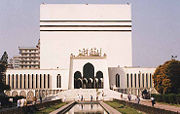
As the most populous city of the nation, Dhaka has a vibrant cultural life. Annual celebrations for Independence Day ( March 26), Language Martyrs' Day ( February 21) and Victory Day ( December 16) are prominently celebrated across the city. Dhaka's people congregate at the Shaheed Minar and the Jatiyo Smriti Soudho to remember the national heroes of the liberation war. These occasions are observed with public ceremonies and rallies in public grounds. Many schools and colleges organise fair, festival and concert in which citizens from all level of society participate.
Pohela Baishakh, the Bengali New Year, falls annually on April 14 and is popularly celebrated across the city. Large crowds of people gather on the streets of Shahbag, Ramna Park and the campus of the University of Dhaka for celebrations. The most popular dressing style for women are sarees or salwar kameez, while men usually prefer western clothing to the traditional lungi. The Durga Puja is the most important Hindu festival of the year. Large processions of Hindus perform devotional songs, dances, prayers and ceremonies for Goddess Durga. The Muslim festivals of Eid ul-Fitr and Eid ul-Adha witnesses widespread celebrations, with large numbers of Muslims attending prayers in mosques across the city; Dhaka being known as the 'City of Mosques'.
For much of recent history, Dhaka was characterised by roadside markets and small shops that sold a wide variety of goods. Recent years have seen the widespread construction of shopping malls, multiplexes, hotels and restaurants attracting Dhaka's growing middle-class and wealthy residents. Along with Bangladeshi cuisine and South Asian variants, a large variety in Western and Chinese cuisine are served at numerous restaurants and eateries. Dhakai Bakarkhani is the traditional food/snack of the people of old Dhaka. It is famous for its quality and taste and it was highly praised by the Royal court of the Mughal empire in Delhi. Despite the growing popularity of music groups and rock bands, traditional folk music remains widely popular. The ghazal songs of artists like Runa Laila and the works of the national poet Kazi Nazrul Islam and national anthem writer Rabindranath Tagore also widespread following across Dhaka. The Baily Road area is known as Natak Para (Theater Neighborhood) which is the center of Dhaka's thriving theatre movement. Indian and Pakistani music and films are popular with large segments of Dhaka's population. This area is also credited for the revival of the Jamdani due to the many local saree stores selling and promoting these locally hand-made age old traditional Bengali sarees. Jamdanis are 100% hand weaved and originated from the Persian and Mughal era. Jamdanis are one of the oldest types of cottage industries which is slowly dying due to its slow production process which is the consequent of maintaining high quality. A single medium range Jamdani saree may take as long as 3 months to complete.
Bangladesh Betar is the state-run primary provider of radio services, and broadcasts a variety of programming in Bangla and English. In recent years many private radio networks specially FM radio services have been established in the city such as Radio Foorty and Radio Today. Bangladesh Television is the state-run broadcasting network that provides a wide variety of programmes in Bangla and English. Cable and satellite networks such as Ekushey Television, Channel I, ATN Bangla, RTV, NTV and STAR TV are amongst the most popular channels. The main offices of most publishing houses in Bangladesh are based in Dhaka. The Prothom Alo and The Daily Ittefaq are the most popular amongst the large number of Bangla language dailies, periodicals and other publications in the city. The Daily Star and The Independent are the largest English-language dailies published in the city. Although cellular phones are gaining popularity, less than 10% of households have telephone access.
Transport
Cycle rickshaws and auto rickshaws are the main mode of transport for the inhabitants of the city, with close to 400,000 rickshaws running each day — the largest number for any city in the world. However, only about 80,000 rickshaws are licensed by the city government. Relatively low-cost and non-polluting cycle rickshaws nevertheless cause traffic congestion and have been banned from many parts of the city. Public buses are operated by the state-run Bangladesh Road Transport Corporation (BRTC) and by private companies and operators. Scooters, taxis and privately-owned automobiles are increasingly becoming popular with the city's growing middle-class. The government has overseen the replacement of two-stroke engine taxis with "Green taxis" locally called CNG, which run on compressed natural gas.
Dhaka has 1,868 kilometres (1,161 mi) of paved roads. It is connected by highways and railway links to Chittagong, Khulna, Mymensingh, Rajshahi, Faridpur and Sylhet. Highway links to the Indian cities of Kolkata and Agartala have been established by the BRTC which also runs regular bus services to those cities from Dhaka. The Kamalapur Railway Station and the Airport (Biman Bandar) Railway Station are the main railway stations providing trains on suburban and national routes operated by the state-run Bangladesh Railway. The Sadarghat Port on the banks of the Buriganga River serves the transportation of goods and passengers upriver and to other ports in Bangladesh. The Zia International Airport is the largest and busiest in the nation. The state-run Biman Bangladesh Airlines is the primary airline corporation based at the airport, although private carriers are gaining popularity.
Education
Dhaka has the largest number of schools, colleges and universities of any Bangladeshi city. The education system is divided into 4 levels: Primary (from grades 1 to 5), Secondary (from grades 6 to 10), Higher Secondary (from grades 11 to 12) and tertiary. The five years of lower secondary education concludes with a Secondary School Certificate (SSC) Examination. Students who pass this examination proceed to two years of Higher Secondary or intermediate training, which culminate in a Higher Secondary Certificate (HSC) Examination. Education is mainly offered in Bangla, but English is also commonly taught and used. A large number of Muslim families send their children to attend part-time courses or even to pursue full-time religious education, which is imparted in Bangla and Arabic in madrasahs.
The Dhaka College is the oldest institution of higher education in the city and amongst the earliest established in British India, founded in 1840. Since independence, Dhaka has seen the establishment of a large number of public and private colleges and universities that offer undergraduate and graduate degrees as well as a variety of doctoral programmes. The University of Dhaka is the largest public university in the nation with more than 30,000 students and 1,300 faculty staff. The university also boasts 18 research centres and 70 departments, faculties and institutes. Eminent seats of higher education include the Jahangirnagar University and the Bangladesh University of Engineering and Technology (BUET). The Dhaka Medical College and the Sir Salimullah Medical College are amongst the largest and most respected medical schools in the nation. Dhaka's college campuses are often hotbeds of political conflicts. Protests and strikes, and violence amongst police, students and political groups frequently disrupt public university campuses.
Sports
Cricket and football are the two most popular sports in Dhaka and across the nation. Teams are fielded in intra-city and national competitions by a large number of schools, colleges and private entities. The Mohammedan Sports Club and Abahani are the largest football and cricket teams, maintaining a fierce rivalry. Many Bangladeshi cricketers and football players such as Sheikh Aslam, Athar Ali Khan, Kaiser Hamid, and Mohammad Ashraful hail from Dhaka. The Bangladesh cricket team's victories over Pakistan in 1999, India in 2004 and 2008 and even the overseas win against Australian cricket team in 2005 were celebrated by thousands of people who congregated on the streets of the city.
Dhaka has the distinction of having hosted the first official test cricket match of the Pakistan cricket team in 1954 against India. The Bangabandhu National Stadium was formerly the main venue for domestic and international cricket matches, but now exclusively hosts football matches. It is a potential host for the opening ceremony of the 2011 Cricket World Cup as well being host to 6 matches to be played in Bangladesh. The Bangladesh Sports Control Board, responsible for promoting sports activities across the nation is based in Dhaka. Dhaka also has stadiums largely used for domestic events such as the Sher-e-Bangla Mirpur Stadium (in Mirpur), the Dhanmondi Cricket Stadium and the Outer Stadium Ground. The Dhaka University Ground hosts many intercollegiate tournaments.
